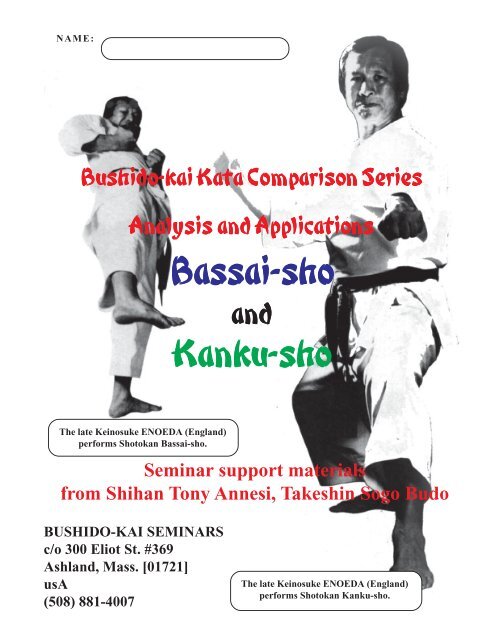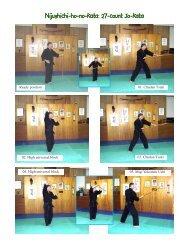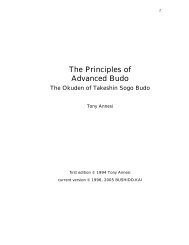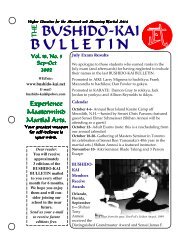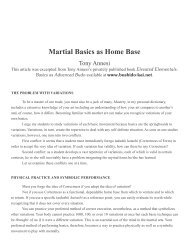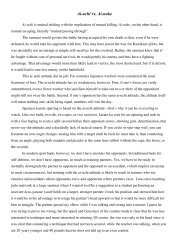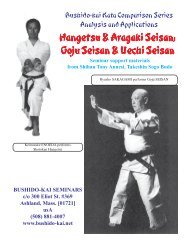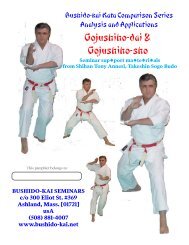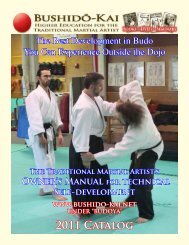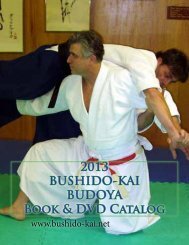Kanku-sho.Bassai-sho.. - Bushido-Kai
Kanku-sho.Bassai-sho.. - Bushido-Kai
Kanku-sho.Bassai-sho.. - Bushido-Kai
Create successful ePaper yourself
Turn your PDF publications into a flip-book with our unique Google optimized e-Paper software.
NAME:<br />
<strong>Bushido</strong>-kai Kata Comparison Series<br />
Analysis and Applications<br />
<strong>Bassai</strong>-<strong>sho</strong><br />
and<br />
<strong>Kanku</strong>-<strong>sho</strong><br />
The late Keinosuke ENOEDA (England)<br />
performs Shotokan <strong>Bassai</strong>-<strong>sho</strong>.<br />
Seminar support materials<br />
from Shihan Tony Annesi, Takeshin Sogo Budo<br />
BUSHIDO-KAI SEMINARS<br />
c/o 300 Eliot St. #369<br />
Ashland, Mass. [01721]<br />
usA<br />
(508) 881-4007<br />
The late Keinosuke ENOEDA (England)<br />
performs Shotokan <strong>Kanku</strong>-<strong>sho</strong>.
BASSAI-SHO & KANKU-SHO<br />
Additional Information compiled by Shihan Tony Annesi<br />
History & Name<br />
• -<strong>sho</strong> signifies the lesser of two (-dai signifies the greater of two)<br />
• <strong>Bassai</strong> means Breaking Through a Fortress; <strong>Kanku</strong> means Viewing the Sky<br />
• <strong>Bassai</strong> was originally the Okinawan Patsai; <strong>Kanku</strong> was originally the Okinawan<br />
Kushanku (or Ko<strong>sho</strong>kun)<br />
• The author of both kata is most probably Yasutsune Itosu; therefore, both forms<br />
are considered Shorin in origin The specific form of both <strong>Bassai</strong>-<strong>sho</strong> and <strong>Kanku</strong>-<strong>sho</strong><br />
may have been based on an separate versions of their –dai counterparts rather than<br />
being smaller versions of the prime forms.<br />
General BASSAI-SHO<br />
• There are at least 11 versions of the <strong>Bassai</strong>: Oyadomari, Tomari, Koryu &<br />
Matsumura among them. <strong>Bassai</strong>-Sho may be one of the other <strong>Bassai</strong> kata adopted<br />
by Shotokan and given the name <strong>Bassai</strong>-Sho.<br />
• These <strong>Bassai</strong> Kata may be descended from Chinese forms known as Ba Ji Ch’uan.<br />
There are 2 forms: Ba Ji Da (<strong>Bassai</strong>-dai?) and Ba Ji Xiao (<strong>Bassai</strong>-<strong>sho</strong>?). Ba Ji Xiao is<br />
written exactly the same way as <strong>Bassai</strong>-Sho. This challenges the popular belief that<br />
all -<strong>sho</strong> kata were created by Itosu.<br />
• <strong>Bassai</strong>-Sho has a unique emphasis on stick defenses and counters. This emphasis<br />
upon reacting to attacks from a stick is supposedly typical of an Itosu created kata,<br />
since all of the kata that he heavily influenced contain stick-countering techniques<br />
within them. Supposedly Itosu’s father used to tie him to a stake and poke at him<br />
with a stick to teach him fighting spirit. According to the legend, Itosu was very<br />
interested in techniques that would take a stick away from his father. The legend<br />
would neatly explain a lot about the origin of stick defense in kata, however, the<br />
whole legend is probably just a story with little basis in truth.<br />
• The last two sword hand blocks at the end of <strong>Bassai</strong>-Dai are apparently new creations.<br />
The ending of <strong>Bassai</strong>-Sho is the original ending for our <strong>Bassai</strong>-Dai kata. This<br />
is evidenced by the Shito-Ryu version of <strong>Bassai</strong>-Dai that still ends with the motions<br />
from the concluding techniques of <strong>Bassai</strong>-Sho.<br />
• <strong>Bassai</strong>-<strong>sho</strong> can be interpreted as a kata done with a bo or, conversely, as a kata for<br />
disarming an opponent with a bo.<br />
General KANKU-SHO<br />
• Yara Kushanku, Kushanku, Kushanku Sho, and Shiho Kushanku are the four<br />
<strong>Kanku</strong> kata.<br />
• Possibly one of Itosu’s creations, <strong>Kanku</strong>-Sho contains many of his typical stick<br />
controlling actions and double punches (especially from a horse stance). This technique<br />
is interpreted by Dr. Schmeisser as an “Istanbul Twist” - a technique where
you grab your opponent by the head and twist his neck violently while flinging him<br />
to the side.<br />
• The stepping punches that quickly withdraw into inside blocks may be taken<br />
from the opening sequence a number of Goju kata.<br />
• For less experienced karate-ka, <strong>Kanku</strong>-Sho presents a true challenge. It is filled<br />
with sequences of jumping and ducking, spinning, and complex multiple technique<br />
combinations. Many of the throwing actions in <strong>Kanku</strong>-Dai are here, but on a smaller<br />
scale. The largest difference between <strong>Kanku</strong>-Dai and <strong>Kanku</strong>-Sho is the timing between<br />
the different applications. For example, in <strong>Kanku</strong>-Dai, there is heavy reliance<br />
upon multiple counters following a blocked attack. While this is one strategy, there<br />
are more effective ways of utilizing timing. In <strong>Kanku</strong>-Sho, there are many sequences<br />
where blocking, sweeping, throwing, and countering are all executed in a single<br />
movement. This is a strategy quite familiar to the advanced students’ repertoire.<br />
<strong>Kanku</strong>-Sho is a definite diversion from <strong>Kanku</strong>-Dai and other kata as far as timing of<br />
application is concerned.<br />
Unfortunately for some, <strong>Kanku</strong>-Sho contains movements which older or less<br />
athletic karate-ka may find impossible to perform with skill. For example, there are<br />
two challenging jumps within the kata.<br />
• <strong>Kanku</strong>-Sho is smaller than <strong>Kanku</strong>-Dai and it requires less time to perform. Also,<br />
many of the techniques in <strong>Kanku</strong>-Sho are on a smaller scale. Nevertheless, many<br />
karate-ka report that <strong>Kanku</strong>-Sho tires them more than <strong>Kanku</strong>-Dai, suggesting that it<br />
is more intensive to perform.<br />
Commentary<br />
• although there are interesting variations and overlaps between the –<strong>sho</strong> and –dai<br />
versions of each kata, there are also interesting comparisons between <strong>Kanku</strong>-<strong>sho</strong><br />
and <strong>Bassai</strong>-<strong>sho</strong>.<br />
• consider the following: use of high and medium manji-uke (swastika block); use<br />
of horse-stance double-punch; use of kake-uke (hook block); use of “wing” arms<br />
when going into hook blocks; use of bo/jo defense; and of arm bars.<br />
References:<br />
BOOKS<br />
• KANAZAWA, Hirokazu, Shotokan Karate International Kata (Vol. 1), 1981.<br />
• MABUNI, Kenei, Karate-do Kata Traditionnel Shito-ryu, SEDIREP, 1995.<br />
• MORRIS, Vince & Aiden TRIMBLE, Karate Kata and Applications (Vol 4 ) Stanley Paul Pub., 1991.<br />
• NAKAYAMA, Masatoshi, Best Karate (Vol. 11), Kodansha International, 1989.<br />
• SAKAGAMI, Ryu<strong>sho</strong>, Karate-do Kata Taikan, Japan Publications, 1978.<br />
WEBsites<br />
• REDMOND, Rob, Shotokan Planet Website (http://www.24fightingchickens.com)<br />
• http://www.karatedojo.com<br />
• http://www.nbkarateclub.it/bunkaibs/bassai<strong>sho</strong>.html<br />
BUSHIDO-KAI SEMINARS, c/o 300 Eliot St., Ashland, Mass. [01721] 508 881-4007<br />
www.bushido-kai.net
Shotokan version<br />
<strong>Kanku</strong>-<strong>sho</strong><br />
(Viewing the Sky,<br />
minor form)<br />
"theoretical"embusen >>><br />
actual embusen >>>
NOTE:<br />
These illustrated outlines of the kata<br />
KANKU-SHO & BASSAI-SHO come from<br />
KARATE-DO NO SHOSAI<br />
(The Details of Karate-do) Volume 5: Sandan<br />
by Shihan Tony Annesi<br />
(Available through BUSHIDO-KAI BUDOYA.<br />
This manual includes 8 other forms, suggested bunkai, as well as<br />
Takeshin Sandan sparring and kicking requirements.)<br />
www.bushido-kai.net
<strong>Bassai</strong>-<strong>sho</strong><br />
( Breaking through a<br />
Fortress, Minor Form )<br />
"theoretical" embusen >>><br />
actual embusen >>>
SIDE VIEW


